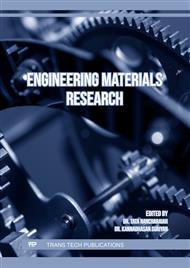[1]
Y. Meng, J. Xu, L. Ma, Z. Jin, B. Prakash, T. Ma, W. Wang, A review of advances in tribology in 2020–2021, Friction. 10 (2022) 1443–1595.
DOI: 10.1007/s40544-022-0685-7
Google Scholar
[2]
Shen, Xue-Hui, Tao, Guo-Can, Tribological behaviors of two micro textured surfaces generated by vibrating milling under boundary lubricated sliding, International Journal of Advanced Manufacturing Technology. (2015).
DOI: 10.1007/s00170-015-6965-x
Google Scholar
[3]
M.S. Suh, Y.H. Chae, Friction characteristic of sliding direction and angle of micro-grooved crosshatch patterns under lubricated contact, in: Adv Mat Res, Trans Tech Publ, 2008: p.507–510.
DOI: 10.4028/www.scientific.net/amr.47-50.507
Google Scholar
[4]
R.A. Singh, N. Satyanarayana, S.K. Sinha, Bio-inspired advanced materials for reducing friction & wear in MEMS devices, in: Adv Mat Res, Trans Tech Publ, 2012: p.359–363.
DOI: 10.4028/www.scientific.net/amr.545.359
Google Scholar
[5]
Z. WU, Y. Xing, P. Huang, Cutting Performance of Fiber Laser Textured Tools in Face Milling of Titanium Alloys, in: Adv Mat Res, Trans Tech Publ, 2017: p.250–253.
DOI: 10.4028/www.scientific.net/amr.1142.250
Google Scholar
[6]
G. Gowthaman, S. Jeyakumar, B.A. Saravanan, A scenario on Dry-WEDM and WEDM for industrial applications, in: Adv Mat Res, Trans Tech Publ, 2020: p.34–42.
DOI: 10.4028/www.scientific.net/amr.1156.34
Google Scholar
[7]
A.G. Demir, B. Previtali, N. Lecis, Development of laser dimpling strategies on TiN coatings for tribological applications with a highly energetic Q-switched fibre laser, Opt Laser Technol. 54 (2013) 53–61.
DOI: 10.1016/j.optlastec.2013.05.007
Google Scholar
[8]
J.W. Byun, H.S. Shin, M.H. Kwon, B.H. Kim, C.N. Chu, Surface texturing by micro ECM for friction reduction, International Journal of Precision Engineering and Manufacturing. 11 (2010) 747–753.
DOI: 10.1007/s12541-010-0088-y
Google Scholar
[9]
F. Yang, C. Pan, Y. Shi, Fabricating Micro-texture on Surface of Cutting Tool Based on NC WEDM Technology, IOP Conf Ser Earth Environ Sci. 440 (2020) 22084.
DOI: 10.1088/1755-1315/440/2/022084
Google Scholar
[10]
T. Matsumura, S. Takahashi, N. Nagase, Y. Musha, Micro dimple milling for structured surface, in: Adv Mat Res, Trans Tech Publ, 2014: p.142–151.
DOI: 10.4028/www.scientific.net/amr.966-967.142
Google Scholar
[11]
K. Liu, H. Wu, R. Huang, N.Y.J. Tan, Ultra-precision Machining of Micro-step Pillar Array Using a Straight-Edge Milling Tool, Nanomanufacturing and Metrology. (2020).
DOI: 10.1007/s41871-020-00076-1
Google Scholar
[12]
S.W. Lee, S.S. Hong, N.C. Chong, Fabrication of micro-pin array with high aspect ratio on stainless steel using nanosecond laser beam machining, Appl Surf Sci. 264 (2013) 653–663.
DOI: 10.1016/j.apsusc.2012.10.087
Google Scholar
[13]
T. Roy, D. Datta, R.B.T.-I.C. on P. Balasubramaniam Meso, Micro and Nano Engineering, Study on the fabrication of micro pillars of varying height and shape simultaneously using Reverse Micro Electrical Discharge Machining, in: 2015.
Google Scholar
[14]
S.K. Saha, S.K. Choudhury, Experimental investigation and empirical modeling of the dry electric discharge machining process, Int J Mach Tools Manuf. 49 (2009) 297–308.
DOI: 10.1016/j.ijmachtools.2008.10.012
Google Scholar
[15]
Cho, Sangbeom, Tummala, Rao, Joshi, Yogendra, Capillary Performance of Micropillar Arrays in Different Arrangements, Nanoscale & Microscale Thermophysical Engineering. (2018).
DOI: 10.1080/15567265.2018.1431749
Google Scholar
[16]
G. Graeber, O.B. Martin Kieliger, T.M. Schutzius, D. Poulikakos, 3D-printed surface architecture enhancing superhydrophobicity and viscous droplet repellency, ACS Appl Mater Interfaces. 10 (2018) 43275–43281.
DOI: 10.1021/acsami.8b16893
Google Scholar
[17]
Q.D. Wang, J.M. Xiao, Y. Li, Experimental study on the through-mask electrochemical micromachining (EMM) process, in: Adv Mat Res, Trans Tech Publ, 2011: p.692–696.
DOI: 10.4028/www.scientific.net/amr.189-193.692
Google Scholar
[18]
C.F. Zhang, S.Y. Xu, F.G. Wang, Current Research Progress of Micro Electrochemical Machining Technology, Adv Mat Res. 411 (2012) 339–343.
Google Scholar
[19]
P. Rodriguez, D. Hidalgo, J.E. Labarga, Optimization of Pulsed Electrochemical Micromachining in Stainless Steel, Procedia CIRP. 68 (2018) 426–431.
DOI: 10.1016/j.procir.2017.12.090
Google Scholar
[20]
L. X., Chen, C. G., Fan, H. C., Lin, Y. B., Dong, N. Z., Guo, Investigation on the electrochemical machining of micro groove using masked porous cathode - ScienceDirect, J Mater Process Technol. 276 (n.d.) 116406.
DOI: 10.1016/j.jmatprotec.2019.116406
Google Scholar
[21]
S. Mahata, S. Kunar, B. Bhattacharyya, Fabrication of Different Micro Patterned Arrays by Through Mask Electrochemical Micromachining, J Electrochem Soc. 166 (2019) E217–E225.
DOI: 10.1149/2.0131908jes
Google Scholar
[22]
B. Wilson, Practice and theory of electrochemical machining, Practice and theory of electrochemical machining, 1971.
Google Scholar
[23]
V.M. Volgin, V. V Lyubimov, T.B. Kabanova, A.D. Davydov, Theoretical analysis of micro/nano electrochemical machining with ultra-short voltage pulses, Electrochim Acta. 369 (2021) 137666.
DOI: 10.1016/j.electacta.2020.137666
Google Scholar
[24]
K. Fan, Z. Jin, J. Guo, Z. Wang, G. Jiang, Investigation on the surface layer formed during electrochemical modification of pure iron, Appl Surf Sci. 466 (2019) 466–471.
DOI: 10.1016/j.apsusc.2018.10.072
Google Scholar


